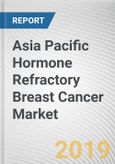Key factors responsible for the growth of this market involve increasing incidences of breast cancers, aging population, demands of advanced therapeutics, increasing prevalence of hormone refractory breast cancers, and the presence of a significant number of anticancer pipeline drugs. Rising life span of cancer-affected population is one of the other factors responsible for the growth of this market. However, social stigma of testing breast cancer lacks technological reach. Insufficient advanced chemotherapeutic treatments restraining the hormone refractory breast cancer market. Substantial number of new chemical entities (NCEs) in various phases of clinical trials will emerge as potential opportunities in the Asia Pacific market.
The Asia Pacific hormone refractory breast cancer market is segmented into China, Japan, India, Australia and others. The Asia-Pacific region is expected to rise at the significant pace, owing to rapid growth of pharmaceutical and healthcare industry along with the improved purchasing power of the service providers in this region. Rapidly emerging economies and the rise of medical tourism in regions such as India and China, will drive the growth of hormone refractory breast cancer market. Rising kidney failure, prevalence rates, in the Asia-Pacific regions should boost the growth of this market.
KEY BENEFITS
The analysis, made in this report, helps in understanding the strategies adopted by various companies for gaining market share in hormone refractory breast cancer market
This report provides a comprehensive analysis of factors that drive and restrict the growth of the hormone refractory breast cancer market
Detailed study of the strategies of key leaders, partnerships, and acquisitions in the Asia Pacific hormone refractory breast cancer market would be informative for professionals in the corporate sector
Pin-point analysis of geographic segments helps to identify opportunities for growth within the hormone refractory breast cancer market
An analysis for the market attractiveness has been included for therapeutics, devices, and geographic regions along with a detailed analysis of factors responsible for the rapid growth of the market segments
Ease of doing business analysis should help in making strategic business decisions
ASIA-PACIFIC HORMONE REFRACTORY BREAST CANCER MARKET KEY SEGMENTS
BY TREATMENT MODALITY
Hormone receptor-based therapy
Tumor markers therapy
Gene expression therapy
Gene mutation therapy
BY GEOGRAPHY
China
Japan
India
Australia
Others
Methodology
The analyst offers exhaustive research and analysis based on a wide variety of factual inputs, which largely include interviews with industry participants, reliable statistics, and regional intelligence. The in-house industry experts play an instrumental role in designing analytic tools and models, tailored to the requirements of a particular industry segment. The primary research efforts include reaching out participants through mail, tele-conversations, referrals, professional networks, and face-to-face interactions.
They are also in professional corporate relations with various companies that allow them greater flexibility for reaching out to industry participants and commentators for interviews and discussions.
They also refer to a broad array of industry sources for their secondary research, which typically include; however, not limited to:
- Company SEC filings, annual reports, company websites, broker & financial reports, and investor presentations for competitive scenario and shape of the industry
- Scientific and technical writings for product information and related preemptions
- Regional government and statistical databases for macro analysis
- Authentic news articles and other related releases for market evaluation
- Internal and external proprietary databases, key market indicators, and relevant press releases for market estimates and forecast
Furthermore, the accuracy of the data will be analyzed and validated by conducting additional primaries with various industry experts and KOLs. They also provide robust post-sales support to clients.

LOADING...








